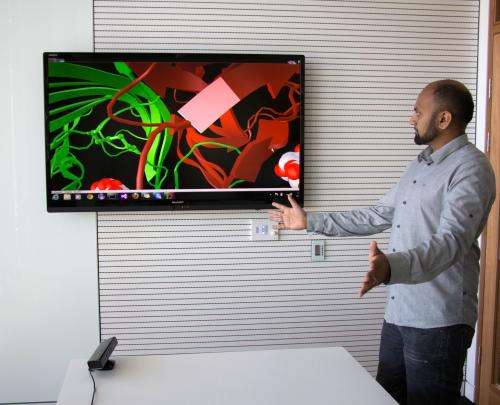Using gesture and voice to control 3D molecular graphics (w/ Video)

Scientists from Sydney's Garvan Institute of Medical Research and CSIRO announced their 'Molecular Control Toolkit' at the 3rd IEEE Symposium on Biological Data Visualization in Atlanta, Georgia, USA on Sunday.
The toolkit is an innovative piece of software designed to connect commercially available gesture and voice recognition devices with any molecular graphics system, allowing people to control 3D representations of molecules with their hands.
3D gesture control is now a standard feature of many computer games, and may become as pervasive as using a mouse or touchpad.
Researchers in the life sciences need to be able to visualise the structures of complex molecules in order to understand their function, model their behaviour and design better drugs.
By connecting the Molecular Control Toolkit with devices such as LeapMotion or Kinect, scientists can use hand movements to rotate a molecule, change the centre of rotation, zoom into and through a molecule, or select a structure of interest.
Previously, to carry out these functions, a researcher first had to learn complex keyboard and mouse combinations. The toolkit now allows intuitive manipulation of a molecule after just a few minutes of instruction.
Earlier this year, 18 life scientists working at Garvan, all with high computer literacy but little experience with 3D gesture control, were invited to test the toolkit. Each person was shown what to do, and then given a few simple tasks to perform. Most participants grasped the basics within half an hour.
Professor Mike Rogers, biochemist and bone researcher, took part in this pilot study, and says he found the experience "fun, tactile and intuitive". "It would be a great tool for giving lectures or presentations, allowing you to manipulate molecules easily with your hands," he said.
"For example, it's a very visually powerful way of highlighting the parts of a protein that might be important for drug binding."
"To our knowledge, this is the first gesture toolkit for molecular graphics that supports multiple devices. It also has a set of controls sufficiently rich to be useful in the day-to-day work of a broad range of life scientists," said team leader Dr Seán O'Donoghue, who works at both Garvan and CSIRO.
A paper describing this work will appear shortly in the IEEE Digital Library.
More information: aquaria.ws/
Provided by Garvan Institute of Medical Research




















